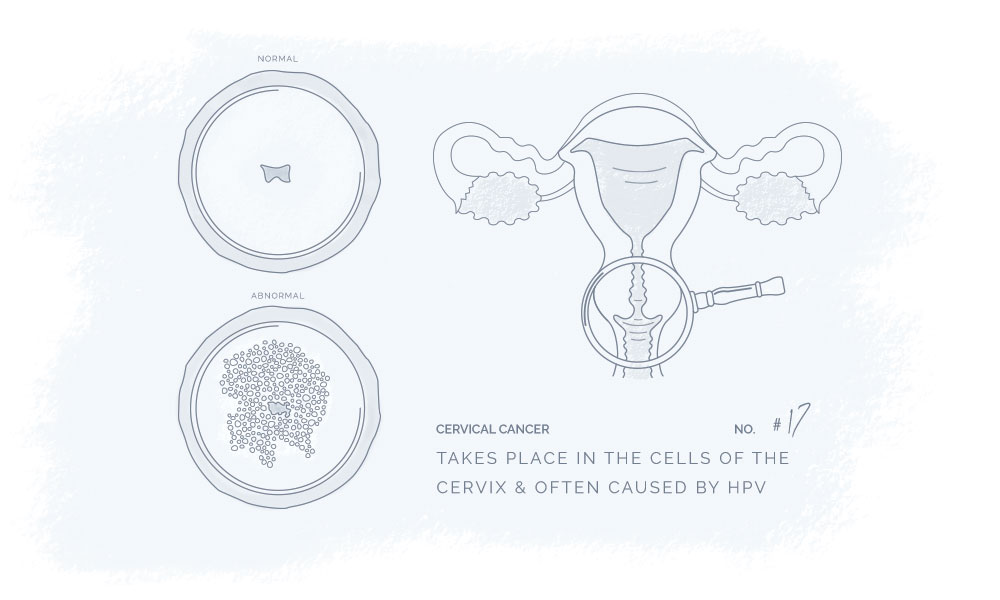Cervical Cancer
Category
Cancer
REVIEWED BY
Our Biomedical Scientist
Reviewed based on
Literature Discussion
Last update
July 2020

What is Cervical Cancer
Cervical Cancer is a type of cancer found in women. It takes place in the cells of the cervix. The primary cause of cervical cancer is the sexually transmitted human papillomavirus (HPV) though the infection may be caused by environmental factors too.1
Symptoms
Signs and symptoms of Cervical Cancer usually do not appear before an advanced stage, meaning that when symptoms do appear, they must be taken very seriously. Signs and symptoms of more-advanced cervical cancer are:1
- Bleeding from the vagina after intercourse, menopause, or between periods
- Pelvic pain
- Pain during intercourse
- Bloody, watery discharge from the vagina that may have a heavy an unpleasant smell
Cause
As other types of cancer, Cervical Cancer involves the growth of abnormal cells that contain mutations leading to uncontrollable cell division and growth. Similarly, it can spread and damage/destroy normal tissue.
Up to this date, the exact cause of cervical cancer is not yet known. However, it is known that HPV is involved in the development of cervical cancer. Furthermore, HPV is prevalent among women and many of them who have the virus do not develop Cervical Cancer, suggesting that other factors may play a role in the development of this cancer, including environmental and lifestyle choices. Please refer to the general cancer entry for more information.1
There are 2 types of cervical cancer
- Squamous cell carcinoma
This type of cervical cancer starts in the thin and fat cells - Adenocarcinoma
This type of cervical cancer starts in the column-shaped glandular cells
Risk factors of cervical cancer
- Unprotected sex with numerous partners
- Early sexual activity
- Other sexually transmitted infections
- Exposure to smoke (squamous cell carcinoma)
- Unbalanced/weakened immune system
The connection between Cannabinoids & Cervical Cancer
Studies find that CBD and THC may have great therapeutic potential and may be used to help treat Cervical Cancer. CBD and THC are well-known cannabinoids, however, they do not have the same psychoactive effects. THC is psychoactive while CBD does not possess psychoactive effects. According to WHO guidelines, the cannabidiol CBD is generally well tolerated with a good safety profile.
Preclinical evidence proposes that the cannabinoid THC may be therapeutic in the treatment of Cervical Cancer as cancer cells express cannabinoid receptors.2
In addition, it has been shown that cell growth can be suppressed by the cannabinoid CBD rather than Cannabis sativa extracts in cervical cancer cell lines. Also, cell death was shown to be induced by CBD rather than Cannabis sativa extracts.3
The literature discussion is an overview of the published results from scientific studies investigating if and how cannabinoids can be beneficial in the treatment of Cervical Cancer. The overview will be updated regularly to ensure the newest and most accurate information.
Anandamide may express anti-cancer properties through cannabinoid receptors
The cervix express cannabinoid receptors such as CB1 , CB2 , and TRPV1, and those receptors are involved in the multiple biological effects of Anandamide.4
Overexpression of TIMP-1 accounts for the anti-invasive and apoptotic functions on cancer cells from Anandamide (and THC) .5
More research is needed to elucidate the specific mechanism of the endocannabinoid system. Some studies propose that TRPV1 and not CB1 or CB2 is responsible for Anandamide anticancer properties.5,6
Clinical trials are research studies that examine new treatments and evaluate their effects on human health outcomes.
Today, we are not able to provide any clinical trials about cannabinoids and Cervical Cancer.
- https://www.mayoclinic.org/diseases-conditions/cervical-cancer/symptoms-causes/syc-20352501
- https://ghmedical.com/endocannabinoid-system/diseases/cervical-cancer
- Lukhele, S., Motadi, L., (2016). ” Cannabidiol rather than Cannabis sativa extracts inhibit cell growth and induce apoptosis in cervical cancer cells”. https://www.ncbi.nlm.nih.gov/pmc/articles/PMC5009497/
Literature - Ayakannu et al., (2015). ” The evolving role of the endocannabinoid system in gynaecological cancer. Hum. Reprod. Update 21, 517–535”. https://academic.oup.com/humupd/article/21/4/517/685435?login=true
- Ramer, R., Hinz, B., (2008).” Inhibition of cancer cell invasion by cannabinoids via increased expression of tissue inhibitor of matrix metalloproteinases-1. J. Natl. cancer Inst. 100, 59–69. https://pubmed.ncbi.nlm.nih.gov/18159069/
- Contassot et al., (2004). ” Arachidonyl ethanolamide induces apoptosis of uterine cervix cancer cells via aberrantly expressed vanilloid receptor-1. Gynecol. Oncol. 93, 182–188”. https://pubmed.ncbi.nlm.nih.gov/15047233/
CANNABINOIDS & RECEPTORS
Below you find the plant cannabinoids, cannabinoid receptors, and endocannabinoids that are associated with the potential therapy.
If you have any further information relevant to the connection between Cervical Cancer and cannabinoids or find any of the information inaccurate, outdated or incomplete please contact us here.

